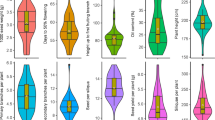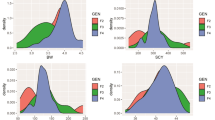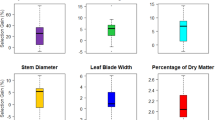Summary
The contribution of two of the major causes of non-normality in the distribution of pure-breeding lines derivable by single seed descent from an F2, namely, linear epistasis and genotype × micro-environment interaction, are examined theoretically by algebraic models and computer simulations. It is shown that all the parameters required for predicting the distribution of the pure-breeding lines including the sign and magnitude of the coefficients of skewness and kurtosis which measure the deviation from normality, can be estimated from the basic set of P1, P2, F1 F2, B1 and B2 generations and an F2 triple test cross.
These predictions are shown to be satisfactory in practice for nine characters in the generations and families derived from the cross between varieties 1 and 5 of Nicotiana rustica. Although the distributions of 80 F11 families derived by single seed descent from this cross display non-normality which is attributable to epistasis and genotype × environment interaction, predictions of their properties which assume normality are satisfactory providing that we make a correction to the expected means of the distributions equal to the epistatic component [i]. This correction accounts for considerably more of the discrepancies between observations and predictions than all other causes including non-normality. In practice, therefore, it appears to be the only correction that needs to be made for data of the kind we have analysed in which there are moderate levels of epistasis and medium to high heritabilities.
Similar content being viewed by others
Article PDF
References
Cornish, M A. 1976. A study of the causes of non-normality in the distribution of inbred lines derived by single seed descent. M.Sc. thesis, Dept. of Genetics, University of Birmingham.
Jinks, J L, and Pooni, H S. 1976. Predicting the properties of recombinant inbred lines derived by single seed descent. Heredity, 36, 253–266.
Perkins, J M, and Jinks, J L. 1970. Detection and estimation of genotype-environmental, linkage and epistatic components of variation for a metrical trait. Heredity, 25, 157–177.
Perkins, J M, and Jinks, J L. 1971. Analysis of genotype × environment interaction in triple test cross data. Heredity, 26, 203–209.
Pooni, H S, and Jinks, J L. 1976. The efficiency and optimal size of triple test cross designs for detecting epistatic variation. Heredity, 36, 215–227.
Snape, J W, and Riggs, T J. 1975. Genetical consequences of single seed descent in the breeding of self pollinating crops. Heredity, 35, 211–219.
Snedecor, G W, and Cochran, W G. 1967. Statistical Methods. Iowa State University Press, Ames, Iowa, U.S.A.
Van Der Veen, J H. 1959. Tests of non-allelic interaction and linkage for quantitative characters in generations derived from two diploid pure lines. Genetica, XXX, 201–232.
Author information
Authors and Affiliations
Rights and permissions
About this article
Cite this article
Pooni, H., Jinks, J. & Cornish, M. The causes and consequences of non-normality in predicting the properties of recombinant inbred lines. Heredity 38, 329–338 (1977). https://doi.org/10.1038/hdy.1977.95
Received:
Issue date:
DOI: https://doi.org/10.1038/hdy.1977.95
This article is cited by
-
Diversification of maize (Zea mays L.) through teosinte (Zea mays subsp. parviglumis Iltis & Doebley) allelic
Genetic Resources and Crop Evolution (2021)
-
QTL for the iron and zinc contents of the milled grains of a doubled-haploid rice (Oryza sativa L.) population grown over two seasons
Journal of Crop Science and Biotechnology (2020)
-
Genetic characterization of maize doubled haploid lines for Fusarium stalk rot caused by Fusarium verticillioides
Journal of Genetics (2020)
-
The inheritance of quantitative traits in Brassica napus ssp. rapifera(swedes): augmented triple test cross analysis of yield
Heredity (1994)
-
Comparison of single seed descent and anther culture-derived lines of three single crosses of rice
Theoretical and Applied Genetics (1993)



